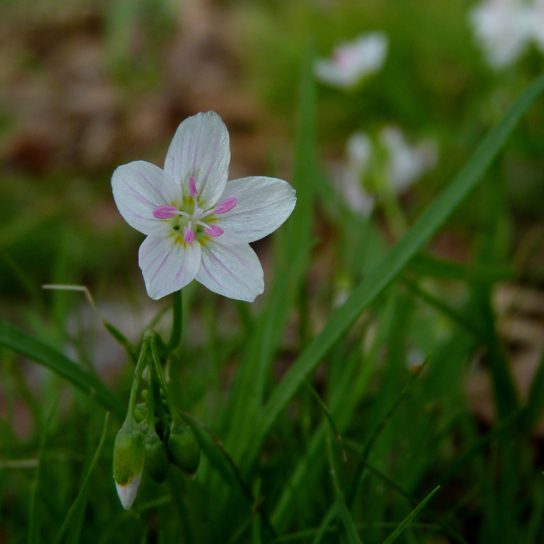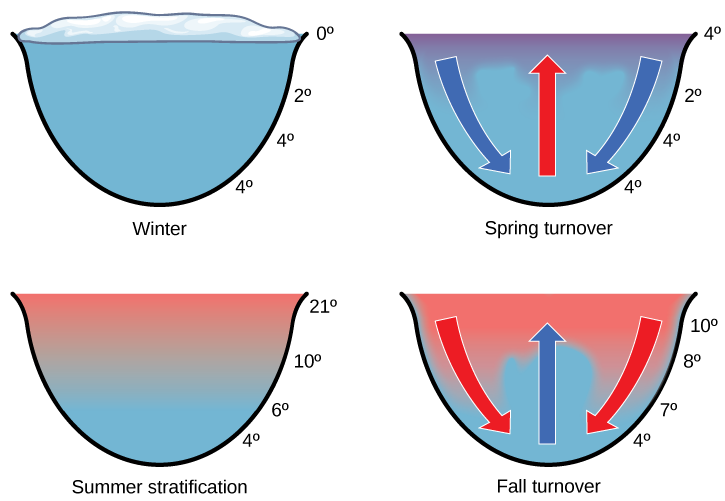44.2: 生物地理学
- Page ID
- 202993
培养技能
- 定义生物地理学
- 列出并描述影响动植物物种全球分布的非生物因素
- 比较非生物力量对水生和陆地环境的影响
- 总结非生物因素对净初级生产力的影响
许多力量影响着存在于生物圈不同部分(地球上生命居住的所有部分)中的活生物体群落。 生物圈延伸到大气层(距离地球几千米)和海洋深处。 尽管生物圈对个人来说显然是广阔的,但与已知的宇宙相比,它只占据了很小的空间。 许多非生物力量会影响生命的存在地点以及生物圈不同部分发现的生物类型。 非生物因素影响生物群落的分布:大面积的土地,气候、动植物群相似。
生物地理学
生物地理学是研究生物的地理分布以及影响其分布的非生物因素。 温度和降雨等非生物因素主要根据纬度和海拔而变化。 随着这些非生物因子的变化,动植物群落的组成也发生了变化。 例如,如果你要从赤道开始一段旅程,然后向北走,你会注意到植物群落的逐渐变化。 在旅程开始时,你会看到热带潮湿的森林,那里有阔叶常绿树,这是赤道附近植物群落的特征。 当你继续向北行驶时,你会看到这些阔叶常绿植物最终会形成季节性干燥的森林,树木分散。 你也会开始注意到温度和湿度的变化。 在北纬约30度处,这些森林将被沙漠所取代,沙漠的特点是降水量少。
向北移动,你会看到沙漠被草原或大草原所取代。 最终,草原被落叶温带森林所取代。 这些落叶林让位于亚北极(北极圈以南地区)的北方森林。 最后,你将到达位于最北纬度的北极苔原。 这次向北跋涉揭示了气候和适应与不同纬度生态系统相关的环境因素的生物类型的逐渐变化。 但是,不同的生态系统存在于同一纬度,部分原因是喷气流、墨西哥湾流和洋流等非生物因素。 如果你要徒步上山,当你移动到更高纬度时,你在植被中看到的变化将与这些变化相似。
研究生物地理学的生态学家研究物种分布模式。 到处都不存在任何物种;例如,金星捕蝇器是北卡罗来纳州和南卡罗来纳州一小部分地区的特有物种。 特有物种是指仅在通常规模有限的特定地理区域中自然发现的物种。 其他物种是通才:生活在各种地理区域的物种;例如,浣熊原产于北美和中美洲的大部分地区。
物种分布模式基于生物和非生物因素及其在物种进化所需的很长时间内的影响;因此,早期的生物地理学研究与十八世纪进化思维的出现密切相关。 一些最独特的动植物组合发生在因地理障碍而物理隔离了数百万年的地区。 例如,生物学家估计,澳大利亚有60万至70万种动植物。 大约有3/4的活植物和哺乳动物物种是仅在澳大利亚发现的特有物种(图\(\PageIndex{1}\))。

有时,生态学家通过确定在哪里找不到物种来发现物种的独特分布模式。 例如,夏威夷没有爬行动物或两栖动物的本土物种,只有一种原生陆地哺乳动物,即苍老的蝙蝠。 再举一个例子,新几内亚的大部分地区缺乏胎盘哺乳动物。
植物可以是特有植物,也可以是通才:特有植物仅存在于地球的特定区域,而通才存在于许多地区。 孤立的陆地,例如澳大利亚、夏威夷和马达加斯加,通常有大量的特有植物物种。 其中一些植物因人类活动而濒临灭绝。 例如,森林栀子花(Gardenia brighamii)是夏威夷特有的;据估计只有 15-20 棵树存在(图\(\PageIndex{2}\)).

Energy Sources
Energy from the sun is captured by green plants, algae, cyanobacteria, and photosynthetic protists. These organisms convert solar energy into the chemical energy needed by all living things. Light availability can be an important force directly affecting the evolution of adaptations in photosynthesizers. For instance, plants in the understory of a temperate forest are shaded when the trees above them in the canopy completely leaf out in the late spring. Not surprisingly, understory plants have adaptations to successfully capture available light. One such adaptation is the rapid growth of spring ephemeral plants such as the spring beauty (Figure \(\PageIndex{3}\)). These spring flowers achieve much of their growth and finish their life cycle (reproduce) early in the season before the trees in the canopy develop leaves.

In aquatic ecosystems, the availability of light may be limited because sunlight is absorbed by water, plants, suspended particles, and resident microorganisms. Toward the bottom of a lake, pond, or ocean, there is a zone that light cannot reach. Photosynthesis cannot take place there and, as a result, a number of adaptations have evolved that enable living things to survive without light. For instance, aquatic plants have photosynthetic tissue near the surface of the water; for example, think of the broad, floating leaves of a water lily—water lilies cannot survive without light. In environments such as hydrothermal vents, some bacteria extract energy from inorganic chemicals because there is no light for photosynthesis.
The availability of nutrients in aquatic systems is also an important aspect of energy or photosynthesis. Many organisms sink to the bottom of the ocean when they die in the open water; when this occurs, the energy found in that living organism is sequestered for some time unless ocean upwelling occurs. Ocean upwelling is the rising of deep ocean waters that occurs when prevailing winds blow along surface waters near a coastline (Figure \(\PageIndex{4}\)). As the wind pushes ocean waters offshore, water from the bottom of the ocean moves up to replace this water. As a result, the nutrients once contained in dead organisms become available for reuse by other living organisms.

In freshwater systems, the recycling of nutrients occurs in response to air temperature changes. The nutrients at the bottom of lakes are recycled twice each year: in the spring and fall turnover. The spring and fall turnover is a seasonal process that recycles nutrients and oxygen from the bottom of a freshwater ecosystem to the top of a body of water (Figure \(\PageIndex{5}\)). These turnovers are caused by the formation of a thermocline: a layer of water with a temperature that is significantly different from that of the surrounding layers. In wintertime, the surface of lakes found in many northern regions is frozen. However, the water under the ice is slightly warmer, and the water at the bottom of the lake is warmer yet at 4 °C to 5 °C (39.2 °F to 41 °F). Water is densest at 4 °C; therefore, the deepest water is also the densest. The deepest water is oxygen poor because the decomposition of organic material at the bottom of the lake uses up available oxygen that cannot be replaced by means of oxygen diffusion into the water due to the surface ice layer.
Art Connection

How might turnover in tropical lakes differ from turnover in lakes that exist in temperate regions?
In springtime, air temperatures increase and surface ice melts. When the temperature of the surface water begins to reach 4 °C, the water becomes heavier and sinks to the bottom. The water at the bottom of the lake is then displaced by the heavier surface water and, thus, rises to the top. As that water rises to the top, the sediments and nutrients from the lake bottom are brought along with it. During the summer months, the lake water stratifies, or forms layers, with the warmest water at the lake surface.
As air temperatures drop in the fall, the temperature of the lake water cools to 4 °C; therefore, this causes fall turnover as the heavy cold water sinks and displaces the water at the bottom. The oxygen-rich water at the surface of the lake then moves to the bottom of the lake, while the nutrients at the bottom of the lake rise to the surface (Figure \(\PageIndex{5}\)). During the winter, the oxygen at the bottom of the lake is used by decomposers and other organisms requiring oxygen, such as fish.
Temperature
Temperature affects the physiology of living things as well as the density and state of water. Temperature exerts an important influence on living things because few living things can survive at temperatures below 0 °C (32 °F) due to metabolic constraints. It is also rare for living things to survive at temperatures exceeding 45 °C (113 °F); this is a reflection of evolutionary response to typical temperatures. Enzymes are most efficient within a narrow and specific range of temperatures; enzyme degradation can occur at higher temperatures. Therefore, organisms either must maintain an internal temperature or they must inhabit an environment that will keep the body within a temperature range that supports metabolism. Some animals have adapted to enable their bodies to survive significant temperature fluctuations, such as seen in hibernation or reptilian torpor. Similarly, some bacteria are adapted to surviving in extremely hot temperatures such as geysers. Such bacteria are examples of extremophiles: organisms that thrive in extreme environments.
Temperature can limit the distribution of living things. Animals faced with temperature fluctuations may respond with adaptations, such as migration, in order to survive. Migration, the movement from one place to another, is an adaptation found in many animals, including many that inhabit seasonally cold climates. Migration solves problems related to temperature, locating food, and finding a mate. In migration, for instance, the Arctic Tern (Sterna paradisaea) makes a 40,000 km (24,000 mi) round trip flight each year between its feeding grounds in the southern hemisphere and its breeding grounds in the Arctic Ocean. Monarch butterflies (Danaus plexippus) live in the eastern United States in the warmer months and migrate to Mexico and the southern United States in the wintertime. Some species of mammals also make migratory forays. Reindeer (Rangifer tarandus) travel about 5,000 km (3,100 mi) each year to find food. Amphibians and reptiles are more limited in their distribution because they lack migratory ability. Not all animals that can migrate do so: migration carries risk and comes at a high energy cost.
Some animals hibernate or estivate to survive hostile temperatures. Hibernation enables animals to survive cold conditions, and estivation allows animals to survive the hostile conditions of a hot, dry climate. Animals that hibernate or estivate enter a state known as torpor: a condition in which their metabolic rate is significantly lowered. This enables the animal to wait until its environment better supports its survival. Some amphibians, such as the wood frog (Rana sylvatica), have an antifreeze-like chemical in their cells, which retains the cells’ integrity and prevents them from bursting.
Water
Water is required by all living things because it is critical for cellular processes. Since terrestrial organisms lose water to the environment by simple diffusion, they have evolved many adaptations to retain water.
- Plants have a number of interesting features on their leaves, such as leaf hairs and a waxy cuticle, that serve to decrease the rate of water loss via transpiration.
- Freshwater organisms are surrounded by water and are constantly in danger of having water rush into their cells because of osmosis. Many adaptations of organisms living in freshwater environments have evolved to ensure that solute concentrations in their bodies remain within appropriate levels. One such adaptation is the excretion of dilute urine.
- Marine organisms are surrounded by water with a higher solute concentration than the organism and, thus, are in danger of losing water to the environment because of osmosis. These organisms have morphological and physiological adaptations to retain water and release solutes into the environment. For example, Marine iguanas (Amblyrhynchus cristatus), sneeze out water vapor that is high in salt in order to maintain solute concentrations within an acceptable range while swimming in the ocean and eating marine plants.
Inorganic Nutrients and Soil
Inorganic nutrients, such as nitrogen and phosphorus, are important in the distribution and the abundance of living things. Plants obtain these inorganic nutrients from the soil when water moves into the plant through the roots. Therefore, soil structure (particle size of soil components), soil pH, and soil nutrient content play an important role in the distribution of plants. Animals obtain inorganic nutrients from the food they consume. Therefore, animal distributions are related to the distribution of what they eat. In some cases, animals will follow their food resource as it moves through the environment.
Other Aquatic Factors
Some abiotic factors, such as oxygen, are important in aquatic ecosystems as well as terrestrial environments. Terrestrial animals obtain oxygen from the air they breathe. Oxygen availability can be an issue for organisms living at very high elevations, however, where there are fewer molecules of oxygen in the air. In aquatic systems, the concentration of dissolved oxygen is related to water temperature and the speed at which the water moves. Cold water has more dissolved oxygen than warmer water. In addition, salinity, current, and tide can be important abiotic factors in aquatic ecosystems.
Other Terrestrial Factors
Wind can be an important abiotic factor because it influences the rate of evaporation and transpiration. The physical force of wind is also important because it can move soil, water, or other abiotic factors, as well as an ecosystem’s organisms.
Fire is another terrestrial factor that can be an important agent of disturbance in terrestrial ecosystems. Some organisms are adapted to fire and, thus, require the high heat associated with fire to complete a part of their life cycle. For example, the jack pine—a coniferous tree—requires heat from fire for its seed cones to open (Figure \(\PageIndex{6}\)). Through the burning of pine needles, fire adds nitrogen to the soil and limits competition by destroying undergrowth.

Abiotic Factors Influencing Plant Growth
Temperature and moisture are important influences on plant production (primary productivity) and the amount of organic matter available as food (net primary productivity). Net primary productivity is an estimation of all of the organic matter available as food; it is calculated as the total amount of carbon fixed per year minus the amount that is oxidized during cellular respiration. In terrestrial environments, net primary productivity is estimated by measuring the aboveground biomass per unit area, which is the total mass of living plants, excluding roots. This means that a large percentage of plant biomass which exists underground is not included in this measurement. Net primary productivity is an important variable when considering differences in biomes. Very productive biomes have a high level of aboveground biomass.
Annual biomass production is directly related to the abiotic components of the environment. Environments with the greatest amount of biomass have conditions in which photosynthesis, plant growth, and the resulting net primary productivity are optimized. The climate of these areas is warm and wet. Photosynthesis can proceed at a high rate, enzymes can work most efficiently, and stomata can remain open without the risk of excessive transpiration; together, these factors lead to the maximal amount of carbon dioxide (CO2) moving into the plant, resulting in high biomass production. The aboveground biomass produces several important resources for other living things, including habitat and food. Conversely, dry and cold environments have lower photosynthetic rates and therefore less biomass. The animal communities living there will also be affected by the decrease in available food.
Summary
Biogeography is the study of the geographic distribution of living things and the abiotic factors that affect their distribution. Endemic species are species that are naturally found only in a specific geographic area. The distribution of living things is influenced by several environmental factors that are, in part, controlled by the latitude or elevation at which an organism is found. Ocean upwelling and spring and fall turnovers are important processes regulating the distribution of nutrients and other abiotic factors important in aquatic ecosystems. Energy sources, temperature, water, inorganic nutrients, and soil are factors limiting the distribution of living things in terrestrial systems. Net primary productivity is a measure of the amount of biomass produced by a biome.
Art Connections
Figure \(\PageIndex{5}\): How might turnover in tropical lakes differ from turnover in lakes that exist in temperate regions?
- Answer
-
Tropical lakes don’t freeze, so they don’t undergo spring turnover in the same way temperate lakes do. However, stratification does occur, as well as seasonal turnover.
Glossary
- aboveground biomass
- total mass of aboveground living plants per area
- biogeography
- study of the geographic distribution of living things and the abiotic factors that affect their distribution
- biome
- ecological community of plants, animals, and other organisms that is adapted to a characteristic set of environmental conditions
- endemic
- species found only in a specific geographic area that is usually restricted in size
- fall and spring turnover
- seasonal process that recycles nutrients and oxygen from the bottom of a freshwater ecosystem to the top
- net primary productivity
- measurement of the energy accumulation within an ecosystem, calculated as the total amount of carbon fixed per year minus the amount that is oxidized during cellular respiration
- ocean upwelling
- rising of deep ocean waters that occurs when prevailing winds blow along surface waters near a coastline
- thermocline
- layer of water with a temperature that is significantly different from that of the surrounding layers



